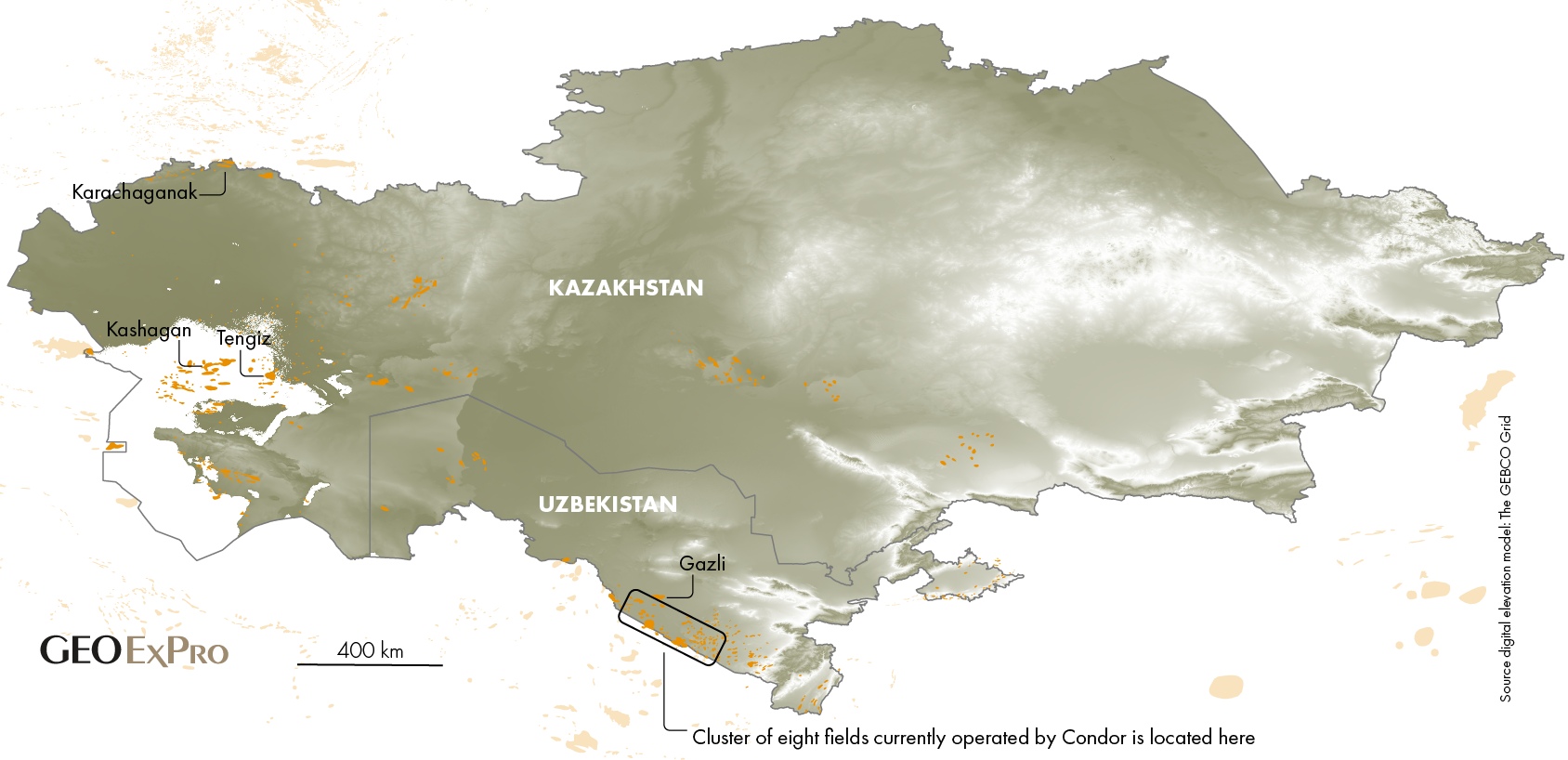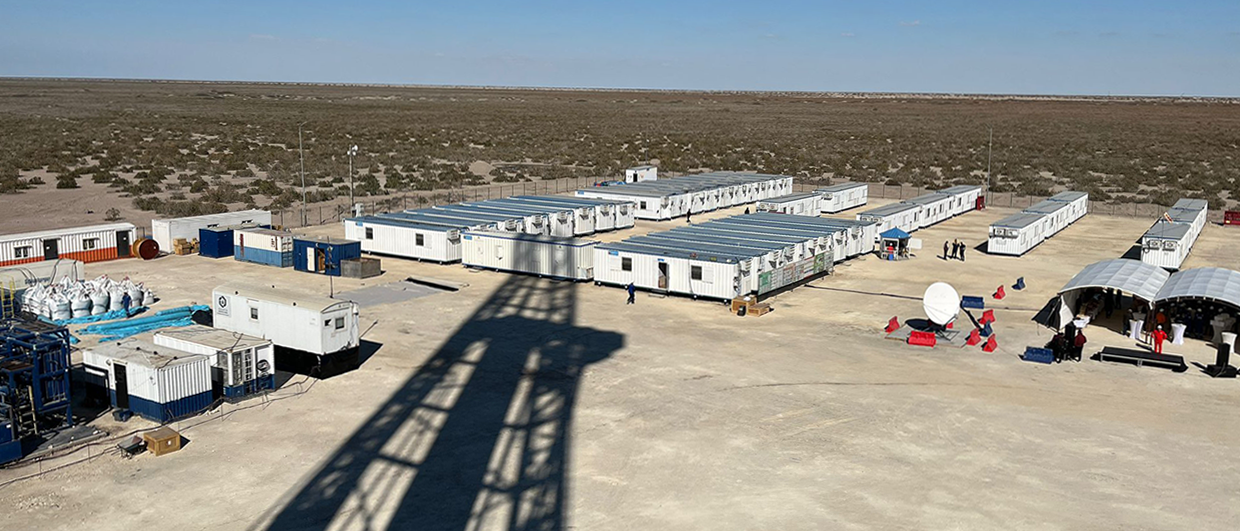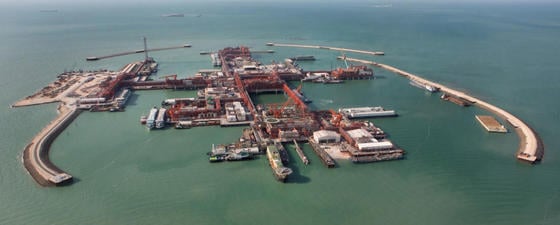Condor Energies (“Condor”) is a Canadian, Calgary-based, publicly listed (Toronto Stock Exchange) energy transition company focused on Central Asia. The company has distinguished itself by building significant operations in KazakhstanKazakhstan and Uzbekistan. Condor has over eighteen years of experience operating in Central Asia.
Central Asia includes the resource-rich nations of Kazakhstan, Uzbekistan, Kyrgyzstan, Tajikistan, and Turkmenistan, and the region has some of the largest oil and gas fields in the world. In Kazakhstan, this includes giant oil and gas fields such as Tengiz, Kashagan, and Karachaganak. These fields all have Western oil majors as partners, including Chevron, Eni, Shell, TotalEnergies and ExxonMobil. In Uzbekistan, this includes the giant Gazli gas-condensate field. Turkmenistan holds the giant Yolotan gas field. Central Asia lies in an optimum location with energy-hungry markets such as Europe to the west and China, India and Pakistan to the east.
In 1991, both Kazakhstan and Uzbekistan gained independence from the Soviet Union. Kazakhstan has a population of 20 million and is producing oil at a rate of 1.8 million barrels per day. In 2024, Kazakhstan produced 60 billion cubic meters of gas. Uzbekistan, with a population of 36 million, in 2024 produced 50 billion cubic meters of gas and minimal volumes of oil. Uzbekistan is planning to produce more gas but will keep most of it at home due to increasing domestic consumption including power generation, industrial uses and household heating.

LNG in Kazakhstan
Condor will be the first company to deliver Liquified Natural Gas (LNG) in Kazakhstan. In 2024, the company received two natural gas allocations to be used as feed gas for the company’s modular LNG production facilities. The company is planning to construct Kazakhstan’s first LNG facilities and produce, distribute, and sell LNG to offset industrial diesel usage in the country. LNG applications include rail locomotives, long-haul truck fleets, marine vessels, mining equipment, and municipal bus fleets. The total LNG fuel produced will have an energy-equivalent volume of over one million liters of diesel daily, while reducing CO2 emissions equivalent to removing more than 38,000 cars from the road annually. These applications have all successfully used LNG fuel in other countries.
Construction of this facility is ongoing, and fabrication works are expected to be completed in the fourth quarter of 2025, with LNG production expected in the first half of 2026.
Critical minerals licenses in Kazakhstan
In 2023, Kazakhstan awarded Condor with its first critical minerals license covering 37,000 hectares. In February 2025, a second contiguous license covering 6,800 hectares was awarded to Condor. The Company holds a 100 % working interest in both licenses.
These licenses are in a heavily faulted geothermally active region, allowing migration of mineralized brines into Carboniferous-age subsurface reservoirs. The licenses offer a significant opportunity to recover lithium, cesium, manganese, rubidium and strontium, minerals of critical importance in the energy transition.
Condor in Uzbekistan
In January 2024, Condor signed a production enhancement services contract with JSC Uzbekneftegaz to increase the production, ultimate recovery and overall system efficiency from an integrated cluster of eight conventional natural gas-condensate fields in Uzbekistan. Giant-size gas fields surround Condor’s operations, including the Gazli field with gas reserves of 190 Bcm (23 TCF). Condor was the first Western strategic operating partner of the national holding company.
Prior to Condor’s participation in the Uz field, production was averaging 10,000 boepd (barrels of oil equivalent per day) from the eight fields with approximately 80 active producing wells and 40 shut-in wells. Production is from Upper Jurassic shelf carbonates. The Uz reservoirs are larger analogues of Western Canada’s prolific Triassic-age Charlie Lake and Mississippian-age Midale Formation platform carbonates. Condor’s strategy is to apply proven Western Canadian technology to abundant workover opportunities in order to grow production.
In June 2024, the company commenced with a multi-well workover campaign for the eight fields, including installing proven artificial lift equipment, perforating newly identified pay intervals, and installing new production tubing. Currently, two workover rigs are being utilized. Production averaged 11,175 boepd in the first quarter of 2025, resulting in Canadian $22.2 million sales (Q1 2025). A very successful recent workover increased overall production to 12,300 boepd in mid-March. At least six additional well candidates have been identified with similar geological characteristics using a combination of legacy data and reprocessed 3D seismic data.
On March 20, 2025, Condor announced its 2024 Year-end Results. Don Streu, President and CEO commented “For Condor 2024 was a transformational year. Our strategy to implement multiple proven Western technologies in Uzbekistan on eight existing gas fields has not only mitigated a 20 % annual natural decline but yielded material production gains from the ongoing workover program and facilities upgrades. As a result, production volumes and revenues continue to increase quarter-on-quarter, which is generating positive netbacks. Results from our recently reprocessed 3D seismic data is providing higher resolutions that should assist with more accurately characterizing the reservoirs and identifying new targets in preparation for a 2025 infill vertical and horizontal drilling program.”
More recently, using advanced cased-hole logging tools and the 3D seismic data, Condor identified a Cretaceous channel sand which flowed at 1,300 boepd on test. The company will further evaluate these channel sands as part of its 2025 infill drilling campaign. Condor Energies is expected to continue to grow in Central Asia due to its effective working relationships with the governments and national oil companies of Kazakhstan and Uzbekistan and application of proven and new technologies to produce LNG and hydrocarbons, all at the doorstep of numerous energy-hungry markets.



